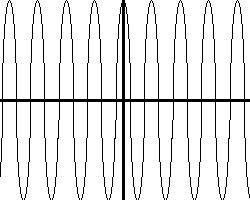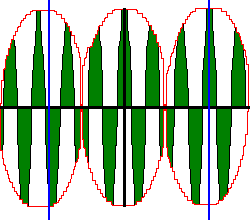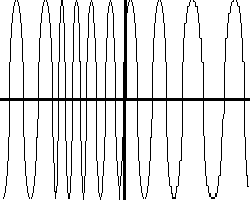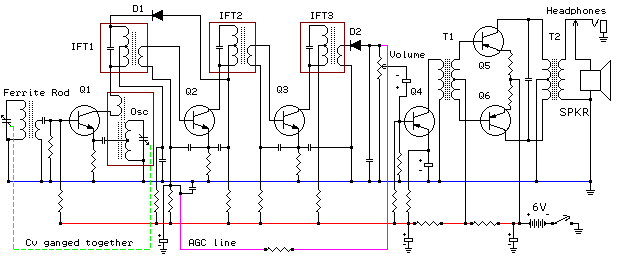
FM Receiver Basics
|
|
|
|
FM Receiver Basics |
|
In a previous tutorial on a.m. receiver design we covered the basics of a typical radio receiver and also covered the earlier types of receivers. They were:
Basic crystal set.
A T.R.F. Receiver.
A Superhetrodyne Receiver.
the Reflex Receiver.
Mainly f.m. receivers are of the superhetrodyne variety. Before we go into any depth about f.m. radio receivers let's consider the principal differences between a.m. and f.m. signals. At first glance it might seem I am merely stating the blinding obvious but the differences are indeed quite profound.
An a.m. receiver relies
upon the original carrier signal (station frequency) having been amplitude
modulated. This means the original amplitude (strength) varies at an audio rate.
Looking at figure 1 we can see an unmodulated carrier signal as it might be seen
on an oscilloscope.

Fig 1. an unmodulated carrier signal
as you can see the amplitude of the carrier signal is unvarying, it remains constant in height looking from the top of the figure to the bottom of the figure. This carrier is common to both a.m. and f.m. signals.
Perhaps the a.m. carrier signal repeats each cycle from point (a) to point (b) - "blue" - in figure 2 below at the rate of 810,000 times a second, this represents a frequency of 810 Khz and would be in the a.m. radio band.

Figure 2. one complete cycle of signal
If the signal were varied at 101,700,000 cycles per second then it would be 101.7 Mhz and located in the f.m. radio band.
Now if the signal of figure 1 is amplitude modulated it looks like the signal in figure 3 below.

Figure 3. - an a.m. modulated signal
Here you will notice that the audio modulating signal which is depicted in red has varied the strength of the carrier signal which is depicted green for purposes of this illustration.
You will note my skills as a graphic artist leave much to be desired (hint: anyone able to contribute oscillograghs in .jpg or .gif formats?) but you should be able to see the carrier sine wave envelope is being varied in strength by the red audio signal. In the receiver circuit a diode detector can convert that envelope above back into the original audio signal for later amplification although some distortion does result.
It was to an extent this distortion property that people sought a better means of transmission. More important it was discovered that noise (either man made QRM or natural noise QRN) was amplitude in its properties.
I have depicted two blue lines in the diagram above, these represent noise impulses caused perhaps by automobile ignition, nearby fluorescent lighting, your computer or atmospheric noise such as a distant storm. Note the blue lines extend beyond the amplitude envelope, they could be many times the magnitude of the received signal.
Nearly everyone has experienced static crashes through an a.m. radio when nearby lightning strikes.
For these reasons frequency modulation evolved. Instead of varying the amplitude of the carrier signal, which remains constant, we vary the carrier frequency more or less by the audio frequency.
If a carrier signal is
frequency modulated (fm) it looks like one below in figure 4

Fig 4 frequency modulated carrier
You should immediately note that the carrier frequency is varying yet the amplitude has remained constant.
This might be a good time
to review the schematic circuit of an a.m. radio receiver.

Fig 5 a.m. bcb radio schematic
Unfortunately the diagram is quite congested because I had to fit it in a space 620 pixels wide.
Now the principle differences between an f.m. radio versus an a.m. radio, and here for the moment we are talking about the entertainment variety, are:
(a) the need for VHF reception capability 88 - 108 MHz as against 0.54 - 1.65 Mhz for a.m. reception.
(b) the need for limiting action in the I.F. stages (see later discussion)
(c) a different means of detection of the audio i.e., recovering the frequency modulation.
(d) if we are talking f.m. stereo reception then some means of recovering left and right channel information.
Collin's Home Page Colin's Amateur Radio Page Colin's Snooker Page Colin's Guest Book Contact Me About Me
This Web page was last updated on Friday September 21, 2001
© 2001 Designed by Colin McCord